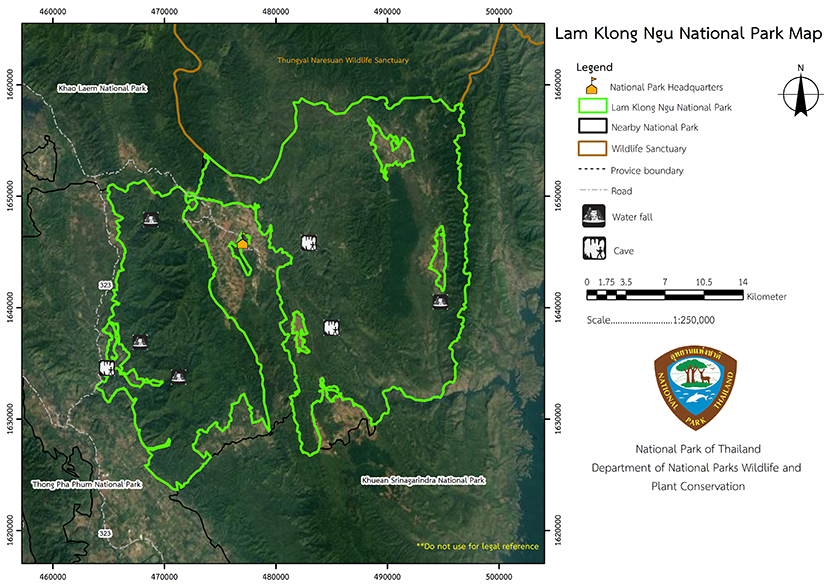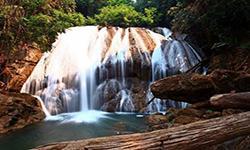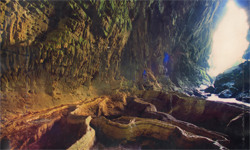Lam Khlong Ngu National Park
Contact Location : Lam Khlong Ngu National Park, PO Box 4, Thong Pha Phum Sub-district, Thong Pha Phum District in Kanchanaburi Province, 71180.
Telephone Number : (+66) 8 4913 2381 (office).
Email : lamklongngoo_np@hotmail.com
Facebook : Lam Khlong Ngu National Park
Information
The Rotary Club of Thong Pha Phum has submitted recommendations to the Royal Forest Department to establish at Khao Phra Ruesi National Reserved Forest, Bo Rae Plot 2, Thong Pha Phum District in Kanchanaburi Province. It has an area of approximately 300,000 rai (480 square kilometers) and was considered as a National Park because there is a fertile forest area and it is a watershed area full of breathtaking natural scenery.
The Royal Forest Department considered the protection of natural forest resources and watersheds by government policy. Therefore, Mr. Sarawut Mueangpra, Forestry Officer Level 5 No. 2237, who served as the superintendent of Phu Muang Forest Park and Phra Thaen Dong Rang Forest Park was order to explore more of the forest area in Kanchanaburi Province, under the National Parks Act of 1961. Mr. Pricha Phurahong, Forestry Officer Level 5, position No. 2225, was assigned to work as the superintendent of Phu Muang Forest Park and Phra Thaen Dong Rang Forest Park. By virtue of Section 19 of the National Reserved Forest Act 1964, the Forestry Technical Officers, Forestry Management Officers, and Forestry Officers, who are competent officials and act as the head of this National Park under the Royal Forest Department's order, have the power to perform any act in the National Reserved Forest for the sake of control, and are able to maintain the National Reserved Forest
Later, Lam Khlong Ngu National Park recevied a letter numbered Ko So 0712.444/56, dated July 7th, 2000, to present information to the National Park Board, about the area being affected by the announcement of the establishment of a National Park. This ensured it did not contravene the National Park Act, 1961, and the area was prepared to be declared as Lam Khlong Ngu National Park.
Lam Khlong Ngu National Park forests are very fertile because this National Park is located in Tanaosi Mountain range, adjacent to Thung Yai Naresuan Wildlife Sanctuary, Khao Laem National Park, and Khuean Sinakharin National Park. Thus, there is a wide variety of flora and fauna and it is most suitable for leisure and learning.
The park contains the highest limestone pillars in the world, at 62.5 meters. It is part of watershed for Sinakarin Dam, which has an area of 375,000 rai or 600 square kilometers. The National Park Division under the Protected Area Regional Office of the Royal Forest Department brought the matter to the consideration of the National Park Committee on October 17th, 2000. The meeting resolved to approve the establishment of a National Park.
Note : After paying the entrance fee to the National Park, please carry the receipt for inspection.

420,374 rai (672.60 square kilometers)
|
|
|
||
Visit Waterfall ⇔ Cave exploration/Geological condition ⇔ Camping
Welfare shop : There are no shops and restaurants. Visitors should prepare necessities, food and beverages.
Mobile phone signal :
- National Park Headquarters: AIS, TRUE, DTAC
- Nang Khruan Waterfall area: DTAC, TRUE (Campground), and AIS (Flagpole)
- Lam Khlong Ngu National Park Ranger Station - Lo Ngo No. 1 (Khao Phra In): AIS (Guard House)
- Sao Hin Cave area: AIS (The Lam Khlong Ngu's magnificent landmark)
|
|
The majority of the area is covered by folded complex mountains, which run north to south. This area is part of Tanaosi Mountain range and ranges in elevation from about 100 to 1,000 meters above sea level with Bo Ngam as the most important peak.
|
|
The area has a tropical monsoon climate, with the southwest monsoon influencing the area in summer and the northeast monsoon influencing the area in winter. This area is characterized by complex valleys, which makes it extremely hot in summer and very cold in winter.
|
|
|
|
|
The overall forest feature of Lam Khlong Ngu National Park is prosperous, containing mixed deciduous forest and a dry evergreen forest. They can be divided into three types: Currently, however, the wildlife is declining in number because humans have cleared and destroyed some forest habitats, forcing some wild animals to migrate to Thung Yai Naresuan Wildlife Sanctuary. The area always has immigrants and they try to makelivelihoods in the area. |
How to get there by car :
From Kanchanaburi Province take National Highway 323 to Thong Pha Phum District and continue onwards for about 16 kilometers to Phutho intersection, turning right after about 12 kilometers. Then drive for another 4 kilometers to reach Lam Khlong Ngu National Park Headquarters.
- National Park Ranger Station Lo Ngo No. 1 (Khao Phra In)
- National Park Ranger Station Lo Ngo No. 2 (Khliti)
- National Park Ranger Station Lo Ngo No. 3 (Huai Suea)
- National Park Ranger Station Lo Ngo No. 4 (Kroeng Krawia)
- National Park Ranger Station Lo Ngo No. 5 (Lam Khlong Ngu)
- National Park Ranger Station Lo Ngo No. 6 (Kriti Lang)
- National Park Ranger Station Lo Ngo No. 7 (Ongthi)
- National Park Ranger Station Lo Ngo No. 8 (Din So)
- National Park Ranger Station Lo Ngo No. 9 (Thung Nang Khruan)
-


